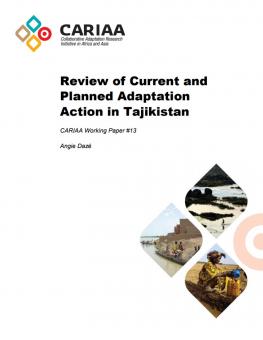
Review of Current and Planned Adaptation Action in Tajikistan
This report summarizes the climate risks and vulnerable sectors in Tajikistan, providing an overview of policies and initiatives introduced in response at the national and sub-national levels.
The mountainous country of Tajikistan is one of the most vulnerable countries in Central Asia to climate change due to its high sensitivity to climate risks and its low adaptive capacity.
This report presents a snapshot of current and planned efforts to address Tajikistan’s vulnerability through climate adaptation actions. It describes how the country is affected by a range of climate risks that negatively impact economic development and the livelihoods of people in rural areas. The Government of Tajikistan has identified reduced water quality and availability (and its consequences for agriculture, energy and health) and increased frequency and severity of natural disasters as its most critical climate change concerns. However, capacity limitations have inhibited progress on integrating climate change into development policies and programs. The ongoing Strategic Program for Climate Resilience aims to address these limitations, with a strong focus on enhancing institutional and technical capacities in climate change and related fields. The ongoing process of developing a national adaptation strategy and action plan will provide further direction on adaptation priorities for government, civil society and private sector actors. These issues are explored more fully in this report, which is one in a series of country reviews prepared by IISD to provide the Collaborative Adaptation Research Initiative in Africa and Asia (CARIAA) with a snapshot of adaptation action in its countries of engagement.
Participating experts
You might also be interested in
Trends in Adaptation Planning: Observations from a recent stock-taking review
This brief provides an overview of observed trends in adaptation action that emerged from a standardized review of efforts in 15 African and Asian countries.
Review of Current and Planned Adaptation Action in Bangladesh
Review of Current and Planned Adaptation Action in India
This report summarizes the climate risks and vulnerable sectors in India, while providing an overview of policies and initiatives introduced at the national and sub-national levels to advance the country’s adaptation actions.
Review of Current and Planned Adaptation Action in Nepal
This report summarizes the climate risks and vulnerable sectors in Nepal, providing an overview of policies and initiatives introduced at the national and sub-national levels to advance the country’s adaptation efforts.